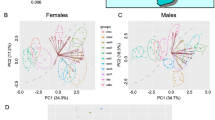Abstract
Studies of short or medium range geographic variations play an increasing role in ecological genetics, and sensitive techniques are required to detect them. In this respect, two sampling techniques were compared inD. melanogaster. The biological data were provided by the analysis of four natural populations from the same geographic area, Spain (one) and Southern France (three), for four morphometrical traits: abdomen and thoracic pigmentation, and wing and thorax lengths. Traits were measured on wild living females and on their progeny reared in the laboratory at 25°C. For progeny analyses, two techniques were compared: the usual isofemale line technique, sib families issued from a single female, and a new isogroup technique, the progeny produced by a group of 20 wild-collected parents. Large phenotypic variations were observed in wild living flies, corresponding to the unstability of natural environmental conditions during their development. Among laboratory grown flies, variations were much smaller. Between isogroups, differences were small, due to sampling error and some common environment effects. Variations between lines were much greater, thus demonstrating a strong genetic component. When different populations have to be compared, the isogroup technique should be preferred since, for the same amount of work, the lesser variability between groups provides a more precise characterization of the population means.
Similar content being viewed by others
References
Alonso-Moraga, A., A. Munoz-Serrano & A. Rodero, 1985. Variation of alloenzyme frequencies in Spanish field and cellar populations ofDrosophila melanogaster. Genet. Sel. Evol. 17: 435–442.
Bakker, K., 1961. An analysis of factors which determine success in competition for food among larvae ofDrosophila melanogaster. Arch. Neerl. Zool. 14: 200–281.
Bulmer, M.G., 1985. The mathematical theory of quantitative genetics. Clarendon Press Oxford.
Capy, P., E. Pla & J.R. David, 1993. Phenotypic and genetic variability of morphometrical traits in natural populations ofDrosophila melanogaster andDrosophila simulans. I. Geographic variations. Genet. Sel. Evol. 25: 517–536.
Capy, P., E. Pla & J.R. David, 1994. Phenotypic and genetic variability of morphometrical traits in natural populations ofDrosophila melanogaster andDrosophila simulans. II. Within population variability. Genet. Sel. Evol. 26: 15–28.
Da Lage, J.L., P. Capy & J.R. David, 1990. Starvation and desiccation tolerance inDrosophila melanogaster: differences between European, North African and Afrotropical populations. Genet. Sel. Evol. 22: 381–391.
David, J.R. & M.F. Clavel, 1965. Interaction entre le génotype et le milieu d'élevage. Conséquences sur les caractéristiques du développement de la drosophile. Bull. Biol. Fr. Belg. 99: 369–378.
David, J.R. & P. Capy, 1988. Genetic variation ofDrosophila melanogaster natural populations. Trends in Genet. 4: 106–111.
David, J.R., P. Fouillet & M.F. Arens, 1978. Utilisation de l'effet fondateur pour mesurer l'hétérogéneité génétique d'une population naturelle: étude de caractères quantitatifs chezDrosophila melanogaster. C. R. Acad. Sci. Paris 286: 129–132.
David, J.R., Y. Cohet, P. Fouillet & M.F. Arens, 1980. Phenotypic variability of wild collectedDrosophila: an approach toward understanding selective pressures in natural populations. Egypt. J. Genet. Cytol. 9: 51–66.
David, J.R., P. Capy, V. Payant & S. Tsakas, 1985. Thoracic trident pigmentation inDrosophila melanogaster: differences between European, North African and Afrotropical populations. Genet. Sel. Evol. 17: 211–224.
David, J.R., P. Capy & J.P. Gauthier, 1990. Abdominal pigmentation and growth temperature inDrosophila melanogaster: Similarities and differences in the norms of reaction of successive segments. J. Evol. Biol. 3: 429–445.
David, J.R., B. Moreteau, J.P. Gauthier, G. Pétavy, A. Stockel & A.G. Imasheva, 1994. Reaction norms of size characters in relation to growth temperature inDrosophila melanogaster: an isofemale lines analysis. Genet. Sel. Evol. 26: 229–251.
Falconer, D.S., 1989. Introduction to quantitative genetics. Longman. London and New York.
Hoffmann, A.A. & P.A. Parsons, 1988. The analysis of quantitative variation in natural populations with isofemale strains. Genet. Sel. Evol. 20: 87–98.
Imasheva, A.G., O.A. Bubli & O.E. Lazebny, 1994. Variation in wing length in eurasian natural populations ofDrosophila melanogaster. Heredity 72: 508–514.
Mather, K. & J.L. Jinks, 1977. Introduction to biometrical genetics. Chapman and Hall. London.
Parsons, P.A., 1980. Isofemale strains and evolutionary strategies in natural populations. Evol. Biol. 13: 175–217.
Parsons, P.A. & S.M.W. Hosgood, 1967. Genetic heterogeneity among the founders of laboratory populations ofDrosophila. Genetica 38: 328–339.
Robertson, F.B., 1963. The ecological genetics of growth inDrosophila. 6. The genetic correlation between the duration of the larval period and body size in relation to larval diet. Genet. Res. 4: 74–92.
SAS Institute Inc., 1985. SAS user's Guide: Statistics, Version 5 ed. SAS Institute Inc., Cary, NC, USA.
STATISTICA Statsoft Inc., 1993. Statistica, Release 4.5, Tulsa, OK, USA.
Vouidibio, J., P. Capy, D. Defaye, J. Sandrin, A. Csink & J.R. David, 1989. Short range genetic structure ofDrosophila melanogaster populations in an Afrotropical urban area, and its significance. Proc. Natl. Acad. Sci. USA 86: 8442–8446.
Author information
Authors and Affiliations
Rights and permissions
About this article
Cite this article
Moreteau, B., Capy, P., Alonso-Moraga, A. et al. Genetic characterization of geographic populations using morphometrical traits inDrosophila melanogaster: Isogroups versus isofemale lines. Genetica 96, 207–215 (1995). https://doi.org/10.1007/BF01439574
Received:
Accepted:
Issue Date:
DOI: https://doi.org/10.1007/BF01439574




